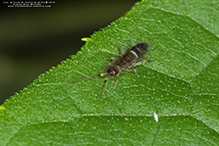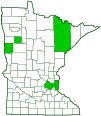belted springtail
(Orchesella cincta)
Conservation • Description • Habitat • Ecology • Distribution • Taxonomy
Conservation Status |
|
|||||||
| IUCN Red List | not listed |
|||||||
| NatureServe | NNR - Unranked |
|||||||
| Minnesota | not listed |
|||||||
Description |
||
Belted springtail is a relatively large slender springtail. It occurs in western Europe, southern Canada, and northern United States. It is one of the most common and one of the largest springtails in the United Kingdom. Based on the number of records, it is uncommon in Minnesota. However, it is probably underreported due to its small size and habitat preferences. It is found in soil, leaf litter, rotting wood, and moss, under stones, and on tree trunks. Adults are elongated, slender, about ⅛″ (4 mm) in length. The head, thorax, abdomen, and legs are covered with long, stiff, erect hairs. They are not covered with scales. The color is variable and may be mostly reddish-brown, brown, or blackish-brown. The head is small. On each side of the head there is a cluster of 7 simple eyes (ocelli) and no compound eyes. The ocelli are minute, no more than 10 microns in diameter. The antennae have 6 segments. Segments 1 and 2 are subdivided. The end of the second segment is white. The third segment is entirely dark and short, much shorter than the second and fourth segments. The fifth and sixth segments are brown. The sixth segment is often missing on just one antenna, suggesting damage earlier in life. First instars have just 4 antennal segments. The thorax has 3 segments, the abdomen 6 segments. There is not a thin black line in the middle through the last two thoracic segments and the first three abdominal segments. The first abdominal segment is short. The second segment has a white band on the rear margin. The band may be narrow or may cover half or more of the segment. The third segment is very dark, making the abdomen appear “belted”. This is the source of the common name of the species. The fourth segment is enlarged and has a forked, tail-like appendage on the underside that allows it to jump. |
||
Size |
||
Total length: ⅛″ (4 mm) |
||
Similar Species |
||
Habitat |
||
Soil, leaf litter, moss, under stones, in rotting wood |
||
Ecology |
||
Season |
||
|
||
Behavior |
||
|
||
Life Cycle |
||
Belted springtails molt throughout their lives, alternating between feeding instars and reproducing instars. When conditions are dry they will cease molting and reproducing until conditions improve. Reproduction is synchronized across a population. |
||
Food |
||
|
||
Distribution |
||||
|
Sources |
|||
| 10/9/2020 | ||||
Occurrence |
||||
|
||||
Taxonomy |
|||
| Class | Collembola (springtails) | ||
Order |
Entomobryomorpha (elongate-bodied springtails) | ||
Superfamily |
Entomobryoidea | ||
Family |
Entomobryidae (slender springtails) | ||
| Subfamily | Orchesellinae | ||
Genus |
Orchesella | ||
Synonyms |
|||
Orchesella vaga Podura cincta |
|||
Common Names |
|||
belted springtail |
|||
Glossary
Instar
The developmental stage of arthropods between each molt; in insects, the developmental stage of the larvae or nymph.
Ocellus
Simple eye; an eye with a single lens. Plural: ocelli.
Visitor Photos |
|||||
Share your photo of this Springtail. |
|||||
| This button not working for you? Simply email us at info@MinnesotaSeasons.com. Attach one or more photos and, if you like, a caption. |
|||||
Alfredo Colon |
|||||
 |
|||||
MinnesotaSeasons.com Photos |
|||||
|
|||||

Slideshows |
||

Visitor Videos |
|||
Share your video of this Springtail. |
|||
| This button not working for you? Simply email us at info@MinnesotaSeasons.com. Attach a video, a YouTube link, or a cloud storage link. |
|||
Other Videos |
|||
| Springschwanz/-tail - Orchesella cincta - Collembola AO1Uta |
|||
About
Jan 18, 2011 0.16 inches springtail and bugs on wooden fence / 4 mm Laufspringer auf dem Gartenzaun Gefilmt am 05.+13. November 2010 |
|||
| Identifying: Magnificent Springtails (Orchesella) James McCulloch |
|||
About
Aug 5, 2020 In this video I introduce one of the more eye-catching springtail genera: Orchesella! Including tips on how to recognise the genus and how to separate the British species. The Collembola Recording Scheme: https://www.brc.ac.uk/scheme/collembola-recording-scheme If anyone has any springtail ID questions, do get in touch! You can find me on Twitter at @My_Wild_Life. |
|||
| Orchesella cincta 68 Philippe Caillon |
|||
About
Mar 22, 2013 |
|||

Created: 12/9/2020
Last Updated:


